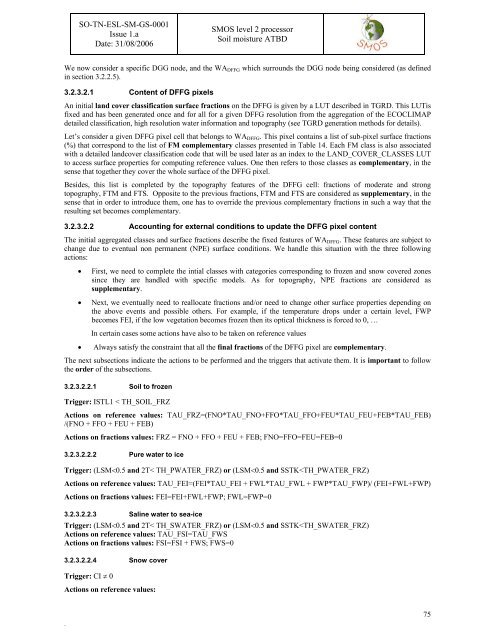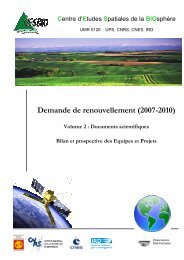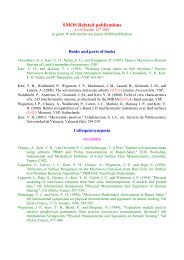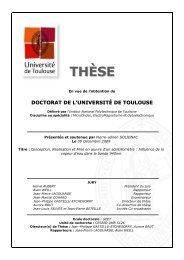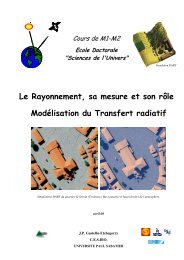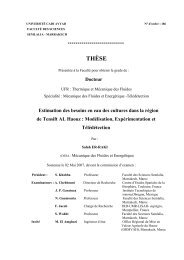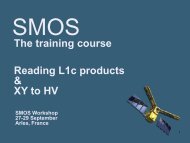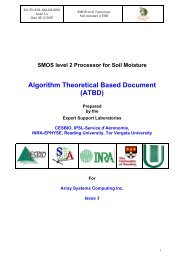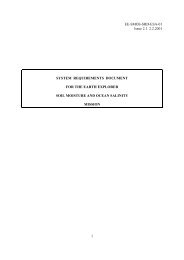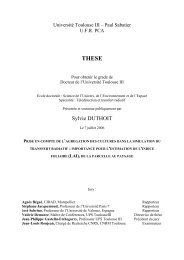Algorithm Theoretical Based Document (ATBD) - CESBIO
Algorithm Theoretical Based Document (ATBD) - CESBIO
Algorithm Theoretical Based Document (ATBD) - CESBIO
Create successful ePaper yourself
Turn your PDF publications into a flip-book with our unique Google optimized e-Paper software.
SO-TN-ESL-SM-GS-0001<br />
Issue 1.a<br />
Date: 31/08/2006<br />
SMOS level 2 processor<br />
Soil moisture <strong>ATBD</strong><br />
We now consider a specific DGG node, and the WA DFFG which surrounds the DGG node being considered (as defined<br />
in section 3.2.2.5).<br />
3.2.3.2.1 Content of DFFG pixels<br />
An initial land cover classification surface fractions on the DFFG is given by a LUT described in TGRD. This LUTis<br />
fixed and has been generated once and for all for a given DFFG resolution from the aggregation of the ECOCLIMAP<br />
detailed classification, high resolution water information and topography (see TGRD generation methods for details).<br />
Let’s consider a given DFFG pixel cell that belongs to WA DFFG . This pixel contains a list of sub-pixel surface fractions<br />
(%) that correspond to the list of FM complementary classes presented in Table 14. Each FM class is also associated<br />
with a detailed landcover classification code that will be used later as an index to the LAND_COVER_CLASSES LUT<br />
to access surface properties for computing reference values. One then refers to those classes as complementary, in the<br />
sense that together they cover the whole surface of the DFFG pixel.<br />
Besides, this list is completed by the topography features of the DFFG cell: fractions of moderate and strong<br />
topography, FTM and FTS. Opposite to the previous fractions, FTM and FTS are considered as supplementary, in the<br />
sense that in order to introduce them, one has to override the previous complementary fractions in such a way that the<br />
resulting set becomes complementary.<br />
3.2.3.2.2 Accounting for external conditions to update the DFFG pixel content<br />
The initial aggregated classes and surface fractions describe the fixed features of WA DFFG . These features are subject to<br />
change due to eventual non permanent (NPE) surface conditions. We handle this situation with the three following<br />
actions:<br />
• First, we need to complete the intial classes with categories corresponding to frozen and snow covered zones<br />
since they are handled with specific models. As for topography, NPE fractions are considered as<br />
supplementary.<br />
• Next, we eventually need to reallocate fractions and/or need to change other surface properties depending on<br />
the above events and possible others. For example, if the temperature drops under a certain level, FWP<br />
becomes FEI, if the low vegetation becomes frozen then its optical thickness is forced to 0, …<br />
In certain cases some actions have also to be taken on reference values<br />
• Always satisfy the constraint that all the final fractions of the DFFG pixel are complementary.<br />
The next subsections indicate the actions to be performed and the triggers that activate them. It is important to follow<br />
the order of the subsections.<br />
3.2.3.2.2.1 Soil to frozen<br />
Trigger: ISTL1 < TH_SOIL_FRZ<br />
Actions on reference values: TAU_FRZ=(FNO*TAU_FNO+FFO*TAU_FFO+FEU*TAU_FEU+FEB*TAU_FEB)<br />
/(FNO + FFO + FEU + FEB)<br />
Actions on fractions values: FRZ = FNO + FFO + FEU + FEB; FNO=FFO=FEU=FEB=0<br />
3.2.3.2.2.2 Pure water to ice<br />
Trigger: (LSM


